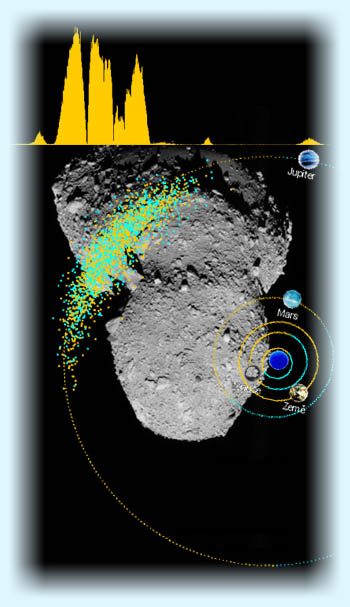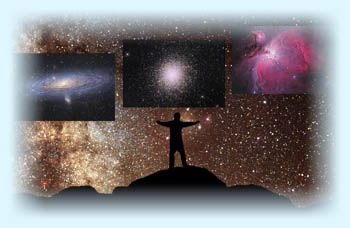Minor planets
Hundreds of thousands of numbered Minor planets whose parameters are periodically (monthly) updates can be used for demonstration of Kepler's laws or display (in different point of view) interesting group of Minor planets.
-
Analysis of Minor planets parameters
Change of one slider of any parameter, the other sliders adjusts to match intervals of Minor planet. You can choose from different groups of Minor planets, e.g. Trojans. For selected (even inhomogeneous) group of Minor planets; parameters can be saved to the file or to use special Data Export.
-
Kirkwood gaps
This is a part of Analysis of Minor planets parameters as a special Data Export. It shows graph of semimajor axes on quantity of minor planets. It can be found several gaps. They correspond to the location of orbital resonances with Jupiter.
-
Historical development
This is a part of Analysis of Minor planets parameters as a special Data Export. It shows graph of year of discovery on quantity of minor planets.
-
Current location in the Solar system
This is a part of Analysis of Minor planets parameters as a special Data Export. It shows location of selected group of minor planet, it is also possible to animate this one by increasing/decreasing of date.
-
Kepler's laws demonstration
It is possible to view current (or for selected date) location in the Solar system for any Minor planet. On this image it is possible to demonstrate all Kepler's laws, including the location of focuses and the center of the ellipse, perihelion, aphelion, mainly the law of equal areas (using the interactive behavior with area calcultion), and more.
-
Apparent magnitude of Minor planet calculation
The image with location of Minor planet in Solar system shows calculated apparent magnitude for given Eart, Sun and minor planet configuration. This value should be also calculated from knowledge of the absolute magnitude and its distance from the Earth and the Sun.
-
Surface temperature of Minor planet estimation
The image with location of Minor planet in Solar system shows estimated temperature in aphelion and perihelion. This aproximate temperature should have the subject in that distance from the Sun.
|
 |
Stars
HIPPARCOS catalogue of stars contains interesting data on more than one hundred thousand stars. Their parallax, apparent magnitude and colour index can be used to construct Hertzsprung-Russell diagram (HRD). Coordinates of stars (right ascension and declination) can be used to determine which stars (or the constellation) are above the horizon, or when they will be most observable. A weekly updated copy of SIMBAD astronomical database can be used for HRD construction.
-
Online H-R diagram
Hertzsprung-Russell diagram generated directly from the HIPPARCOS catalogue of stars or the SIMBAD astronomical database. It allows to view HR diagram for stars in selected distances and it displays the location of the selected stars in the diagram.
-
Advanced Search of the HIPPARCOS catalogue
With this Advanced Search on HIPPARCOS catalogue it is possible to obtain and store raw data from catalogue based on input rules. With these data Hertzsprung-Russell diagram can be constructed in spreadsheet.
-
Sun below horizon
Sunset and sunrise
Twilights
Graphical representation of the sun below the horizon to the chosen location for a selected time. It begins before sunset and ends after sunrise next day. There are highlighted all twilights.
-
(Circumpolar) constellations
List of constellations visible at a given time and place on the sky including an indication of circumpolar constellations.
-
Length of (astronomical) night (equinox, solstice)
For selected day it is calculated length of night (from sunset to sunrise) and length of astronomical night (interval, when the sun is more than 18° below the horizon). It is possible to demonstrate the situation for equinox whether night and day is realy equal, it means both have 12 hours.
-
Sidereal and solar time
For any star (if we know right ascension) it is possible to calculate the day of its best visibility, it means find the day when the star culminates in a given place at midnight. For this calculation it is suitable to know of the difference between sidereal and solar time.
|
 |
Deep-sky objects
Two very famous catalogues (Messier and NGC) contain nearly eight thousand nebulae, star clusters and galaxies.
-
Nebulae, star clusters and galaxies on the sky
For any time between sunset and sunrise it can be displayed sorted list of deep sky objects that can be observed. Objects are selected from the Messier and NGC catalog. For NGC list you can set the apparent magnitude limit. For each object the azimuth and elevation above the horizon is calculated.
|
 |
Stránka byla naposledy editována 12. července 2015 v 22:30.
Stránka byla od 15. 1. 2010 zobrazena 4620krát.








